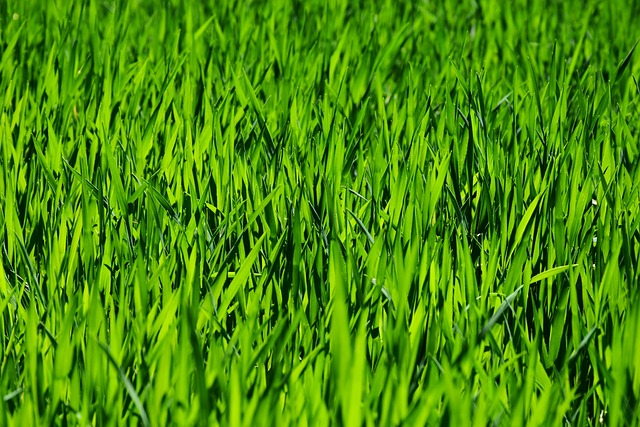Revitalizing your outdoor space into a vibrant environment with sustainable and innovative lawn care practices is key for both aesthetic appeal and environmental health. By adopting organic maintenance methods over synthetic alternatives and implementing composting techniques and soil amendments, you can significantly improve the nutrient content of your lawn, creating a thriving grass ecosystem. The use of native plants not only enhances natural beauty but also supports local biodiversity. Water conservation is emphasized through efficient drip irrigation systems that deliver water directly to plant roots, reducing waste. Combining traditional lawn care methods with modern innovations can transform your yard into an inviting oasis that balances a pristine appearance with ecological sustainability. Lawn Care and Landscaping are central to creating this harmonious blend of art and science, ensuring your outdoor space is both beautiful and beneficial for the environment. Homeowners are increasingly prioritizing sustainable practices in lawn care and landscaping, focusing on water conservation, reduced chemical use, and biodiversity promotion. Eco-conscious garden maintenance methods like native plants, xeriscapes, and organic pest management, along with smart irrigation systems and composting, further support this shift towards a more sustainable approach to outdoor spaces. This not only offers a harmonious connection with the outdoors but also significantly contributes to environmental conservation, making it an environmentally responsible choice for those looking to revamp their lawns and landscapes.
Transforming residential outdoor spaces into vibrant, functional extensions of one’s home has become a significant trend in contemporary landscaping. This article delves into innovative strategies for revitalizing your outdoor oasis, creating harmonious gardens, and designing year-round living havens through Lawn Care and Landscaping practices. From assessing your lawn’s condition to understanding soil composition for optimal plant growth, this guide offers practical advice on sustainable landscaping, eco-friendly pest control, and efficient irrigation systems. Discover how to select the right turf and plants for your climate, enhance curb appeal with strategic border plants and mulch, and maintain a lush lawn through seasonal maintenance and aeration. Learn to design a garden layout that complements your home’s functionality, incorporate diverse planting for both resilience and beauty, and craft outdoor living spaces that offer comfort and ambiance all year round. Whether you’re looking to refresh your patio or transform your entire backyard into an oasis, these insights will guide you in creating an outdoor environment that reflects the essence of Lawn Care and Landscaping excellence.
- Revitalizing Your Outdoor Oasis: Innovative Lawn Care Strategies for Vibrant Spaces
- – Assessing Your Lawn's Current Condition
- – Implementing Sustainable Landscaping Practices
Revitalizing Your Outdoor Oasis: Innovative Lawn Care Strategies for Vibrant Spaces

Revitalizing your outdoor oasis into a vibrant space begins with innovative lawn care strategies that cater to both aesthetic appeal and environmental sustainability. Today, eco-friendly landscaping practices are at the forefront, emphasizing organic maintenance over chemical treatments. By integrating composting techniques and soil amendments, homeowners can enhance nutrient levels in their lawns, fostering a healthier and more resilient grass ecosystem. Additionally, the strategic placement of native plants not only complements the natural landscape but also supports local biodiversity. Drip irrigation systems, which conserve water by delivering it directly to plant roots, are another cornerstone of modern lawn care. These systems ensure that your outdoor space remains lush and green without unnecessary water waste. By adopting a holistic approach to lawn care, integrating both traditional practices and cutting-edge innovations, you can transform your yard into an inviting oasis that harmonizes with the environment. Landscaping becomes an art of balance, where maintaining a pristine lawn goes hand in hand with promoting ecological health.
– Assessing Your Lawn's Current Condition

As homeowners seek to enhance their living spaces, the focus on residential outdoor areas has seen a significant uptick. A key aspect of this transformation is the meticulous assessment and subsequent care of lawns. Understanding your lawn’s current condition is paramount for any landscaping project. Homeowners should begin by evaluating grass health, soil quality, and environmental factors that influence growth. This involves inspecting for signs of disease or pest infestation, assessing the thickness and resilience of the turf, and considering the amount of sunlight and water the lawn receives. Lawn Care is a multifaceted endeavor that requires attention to detail; it’s about more than just mowing and fertilizing. A thorough assessment will inform a tailored landscaping plan, ensuring that your outdoor space thrives and becomes an extension of your home’s comfort and aesthetic appeal. By leveraging professional lawn care services or utilizing online resources for guidance, homeowners can make informed decisions to nurture their green spaces effectively. Implementing the right mix of soil amendments, selecting appropriate grass varieties for your climate, and employing effective irrigation systems are all critical steps in the landscaping process. These efforts not only elevate the beauty and functionality of your outdoor environment but also contribute to a healthier and more sustainable living space.
– Implementing Sustainable Landscaping Practices

The transformation of residential outdoor spaces has seen a significant shift towards sustainability, particularly in lawn care and landscaping practices. Homeowners are increasingly adopting eco-friendly approaches to maintain their gardens, recognizing the importance of conserving water, reducing chemical use, and promoting biodiversity. Sustainable landscaping involves thoughtful design that maximizes native plants, minimizes turf areas, and integrates features like rain gardens and xeriscapes. These practices not only conserve resources but also create resilient outdoor environments that can thrive with minimal maintenance. By selecting drought-resistant species and employing organic methods to manage pests and diseases, landscapes become healthier and more self-sufficient. This shift not only contributes to environmental conservation but also offers homeowners a sense of connection with their surroundings, fostering a harmonious relationship between the home and its environment.
Moreover, the integration of smart irrigation systems and composting practices further enhances the sustainability of residential outdoor spaces. These systems efficiently use water resources, ensuring that lawns and gardens receive optimal hydration without waste. Composting, on the other hand, enriches the soil, reducing the need for synthetic fertilizers. The organic matter from compost supports plant growth and improves soil structure, contributing to a healthier ecosystem within the home’s outdoor space. As a result, these sustainable landscaping practices not only beautify the property but also play a crucial role in environmental stewardship, making them an essential consideration for anyone looking to transform their outdoor areas responsibly.
In conclusion, the transformation of residential outdoor spaces into vibrant, sustainable oases is achievable through innovative lawn care and thoughtful landscaping practices. By carefully assessing your lawn’s current condition and embracing sustainable landscaping strategies, homeowners can enhance both the beauty and health of their outdoor environments. These efforts not only contribute to a more enjoyable living space but also support environmental conservation. Embracing these principles in lawn care ensures that your outdoor space remains a lush and inviting area for years to come, making it an extension of your home where you can relax, entertain, and connect with nature.
